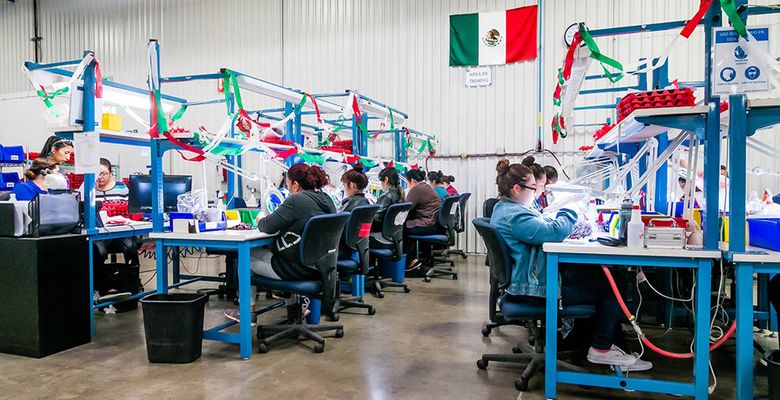
Nearshoring makes a comeback in the north of Mexico.
Last year, the global pandemic forced every industry to reimagine its business models due to the collapse of production lines originated with the suspension of non-essential activities across the world. However, the demand for goods and services via e-commerce outlets increased thus urging many companies to expand their logistics centers and find suppliers near the final assemble factory.
The necessity for nearshoring –the practice previously described – in the manufacturing industry boosted the growth of industrial complexes in Mexico, particularly of those located in the north of the country, because of its strategic ubication and the USMAC support. American and Canadian companies benefited from the Mexican manufacturing for their products because of its proximity compared to the Asian companies that usually act as suppliers, shortening the distance in production lines.
Solili – a real estate data research and analytics platform – suggests that Mexican cities such as Tijuana, Guadalajara, Monterrey, and Mexico City overcame the industry demand in 2019 by showing to foreign investors a great capacity to welcome recognized companies from any sector in their territories as well as endurance and solidity during crisis times. Just Mexico City alone reported a gross demand of 260,000 m² of industrial spaces in the last quarter of 2020 as a result of the expansion of e-commerce and logistics companies, essentials to strengthen any supply chains.
Outside of the Mexico City Metropolitan Area, the north of Mexico is the zone that shows a bigger increase of demand for industrial spaces. Monterrey ended 2020 with a gross demand of 195,000 m², an annual growth of 58% compared to 2019, supported by logistics, retail, automobile, and manufacturing companies. Tijuana also registered an annual growth of 43% due to the arrival of logistics, medical, food, manufacturing, and metalworking industries while Ciudad Juárez finished the last quarter of the year with a total demand of 43,000 m² for enterprises of the logistics, automobile, and manufacturing sectors.
Because of its strategic position between the north and the Mexican Bajío, Guadalajara closed 2020 with a gross demand of 90,000 m² favored by logistics, tobacco, storage, and medical companies. It’s important to notice that the market had a low vacancy and space incorporation rate.
On the other hand, the Bajío market displays a decrease of demand due to the shortage of requests for the lasting and semi-lasting goods that characterize the area.
Regarding vacancy levels, these continue a healthy trend across all Mexican markets by averaging 4.6% at the end of the last quarter of 2020. Guanajuato, with an 8.6% vacancy, has the highest rate in the country, a coherent indicator with other cities in the center region like Mexico City, Puebla, and Querétaro that also increased up to 30% their respective vacancy rates. Nevertheless, Guadalajara and cities in the north region such as Tecate, Saltillo, and Mexicali reported a downward trend whereas Tijuana and Monterrey showed similar patterns to the ones in the same period of 2019.
Because of the low availability of empty industrial spaces and the currency of Mexican peso compared to the US dollar, rental prices for industrial spaces nationwide increased between 5 and 10% this year. There are a few markets that lowered their prices, including Querétaro with a 3.5% and San Luis Potosi with a 2.9% price drop from 2019.
Finally, the pattern in the indicators of demand, vacancy and prices have allowed developers to start new industrial projects that were in the planning stage thus increasing the available m² in 25%.
In Mexico City, almost 150,000 m² started to be built to increase the available industrial spaces inventory to satisfy the demand in the north and center areas of the capital, especially in Tepotzotlán and Tultitlán. Commercial corridors in the north of the Metropolitan Area of Mexico City are medium-term projections to detonate infrastructure and investments by creating industrial complexes in empty lots.
Monterrey, the second largest industry city nationwide, registered nearly new 177,000 m² from 11 projects – and almost half of them are already pre-leased. Also, another 13 projects started construction work, an optimistic indicator for an economic recovery after the pandemic.
Guadalajara is another city that reported an important growth by increasing 120% its available space to adjust for the demand. Tijuana, on the other hand, reduced the construction of new industrial spaces.
Industrial cities like Tijuana, Guadalajara, Monterrey, Ciudad de México, Querétaro, Guanajuato, Chihuahua, Zapopan y Toluca have great connectivity to others in Mexico to speed up the supply chain. Some of those cities are Puebla, Zacatecas, Durango, Gómez Palacio, Torreón, Saltillo, Tampico, Mexicali, Hermosillo, Obregón, Los Mochis, Culiacán, Mazatlán y Tepic.